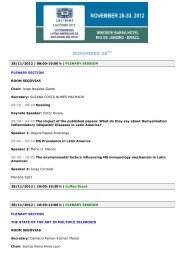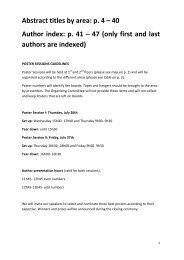Keynote Conference - Interevent
Keynote Conference - Interevent
Keynote Conference - Interevent
Create successful ePaper yourself
Turn your PDF publications into a flip-book with our unique Google optimized e-Paper software.
L#19<br />
Regulation of insect metamorphosis and the role of<br />
microRNAs. Nepenthe teams up with Psyche<br />
Xavier Bellés<br />
Institute of Evolutionary Biology (CSIC-UPF), Barcelona<br />
E-mail: xavier.belles@ibe.upf-csic.es<br />
Insect metamorphosis has fascinated mankind since the time of<br />
Aristotle, some two thousand years ago. But it was not until<br />
the decade of 1930 that the studies of Vincent B. Wigglesworth<br />
showed that insect metamorphosis is regulated by two<br />
hormones: the molting hormone, which induces the successive<br />
molts, and the juvenile hormone, which maintains the juvenile<br />
character of them. Then, a number of transcription factors act<br />
as mediators of these hormones, as well as a number of target<br />
genes that codify for proteins, giving the shape and behaviour<br />
of a juvenile or an adult stage. Working on the cockroach<br />
Blattella germanica, we found that microRNAs, which are RNAs<br />
of ca. 22 nucleotides that play a repressing action on mRNA,<br />
have a key role in metamorphosis. We silenced the expression<br />
of dicer-1 (a ribonuclease that mediates the maturation of<br />
microRNAs) in the last nymphal instar and the cockroaches,<br />
instead of molting to the adult stage, transformed into<br />
supernumerary nymphs. We presume that there are<br />
microRNAs that repress the expression of genes that maintain<br />
the juvenile status quo (like Nepenthe, the drug of<br />
forgetfulness of the Greeks). This leads to a change of genetic<br />
program, from juvenile to adult and, within the latter, there<br />
must be other microRNAs that modulate and refine the<br />
expression of genes that give rise to the adult animal, thus<br />
making it all right (like Psyche, the Greek symbol of<br />
transformation and new life).<br />
L#20<br />
The prion protein as a prototypical cell surface scaffold protein.<br />
Rafael Linden<br />
Instituto de Biofísica da UFRJ, Rio de Janeiro, Brazil.<br />
Based on multiple interaction partners and pleiotropic signaling<br />
properties, we proposed the hypothesis that the prion protein<br />
(PrPC) is a cell surface scaffold protein, that serves as a dynamic<br />
platform for the assembly of signaling modules involved in<br />
widespread systemic functions. Our recent work is focused on 3<br />
topics: (a) identification and validation of additional molecular<br />
interactions of PrPC; (b) structural evidence for allosteric<br />
function of PrPC; (c) functional properties and dysfunction of<br />
PrPC beyond the nervous system. A phage display screen,<br />
together with evidence from PrPC-null mice, implicate several<br />
neurotransmitter receptors and/or transporters in PrPCdependent<br />
signaling; Biophysical techniques showed that<br />
interaction of PrPC with its ligand hop/STI1 entails reciprocal<br />
structural remodeling, and strongly suggest allosteric effects<br />
that may be involved in the propagation of signals through PrPCmediated<br />
multiprotein complexes; Beyond the nervous system,<br />
we found that both peripheral inflammation and behavioral<br />
stress modulate the content of PrPC at the plasma membrane of<br />
neutrophils, with consequences upon peroxide-dependent<br />
cytotoxicity towards vascular endothelial cells. Our studies add<br />
to the understanding of both allosteric properties of the prion<br />
protein and systemic control of its expression and function. The<br />
data are consistent with the scaffold hypothesis that explains<br />
the multiple roles of the prion protein in physiology and<br />
pathology, and further suggest that PrPC may be relevant for<br />
clinically observed associations of stress and anxiety with either<br />
the severity or the progression of various degenerative/<br />
noncommunicable diseases.<br />
(Supported by CNPq, FAPERJ, CAPES, FAPESP)<br />
52





